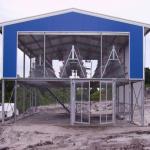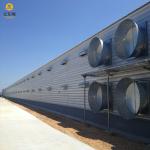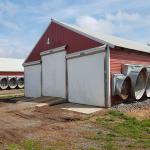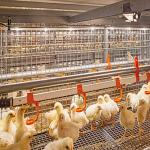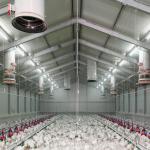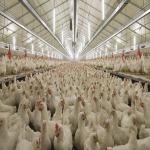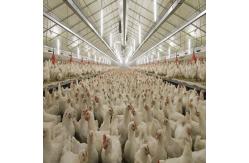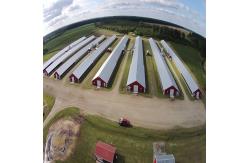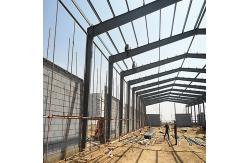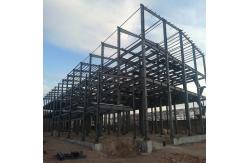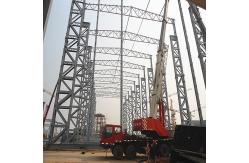Steel Structure Chicken House Beautiful and Practical Long Span
Steel Structure Building
Steel-Structure Poultry House: Overview, Features, and Applications
1. OverviewSteel-structure poultry houses are modern agricultural facilities
designed for efficient, large-scale poultry farming (chickens,
ducks, geese, etc.). Utilizing steel frameworks (e.g., H-beams,
cold-formed thin-walled steel) as the primary load-bearing
structure, these buildings integrate modular design, advanced
insulation, automated systems, and biosecurity measures. They are
widely adopted to meet the demands of high-density farming,
environmental sustainability, and animal welfare in the 21st
century.
2. Key Features(1) Durability and Structural Advantages- High Strength: Steel’s tensile strength withstands extreme weather (typhoons,
heavy snow) and long-term mechanical loads.
- Corrosion Resistance: Galvanized coatings or anti-rust treatments extend lifespan
to 30–50 years, outperforming traditional brick-wood structures.
- Seismic Resilience: Flexible steel frameworks reduce damage risks in earthquake-prone
areas.
(2) Rapid Construction and Customization- Modular Prefabrication: Factory-made components enable on-site assembly within 1–3 weeks, minimizing weather-related delays.
- Design Flexibility: Adjustable spans (8–30m) and heights accommodate diverse farming
scales, equipment layouts, and automation needs.
(3) Energy Efficiency and Sustainability- Thermal Insulation: Polyurethane/PIR sandwich panels reduce heat loss by 30–50%, optimizing temperature control.
- Renewable Integration: Solar panels on rooftops or facades cut energy costs; rainwater
harvesting systems support sustainable water use.
- Recyclability: Steel is 100% recyclable, reducing construction waste and carbon
footprint.
(4) Hygiene and Automation- Smooth Surfaces: Seamless steel walls and floors prevent pathogen buildup,
simplifying disinfection.
- Smart Farming: Automated feeding, egg collection, and manure removal systems
enhance efficiency while minimizing human-poultry contact.
- Ventilation Systems: Negative-pressure ventilation maintains ammonia levels
below 25ppm, ensuring air quality.
3. Applications and Best PracticesIdeal Scenarios- Large-Scale Farms: Houses 50,000–200,000 birds per unit, suitable for broiler,
layer, or breeder operations.
- Harsh Climates: Performs well in high-humidity, windy, or cold regions due to
robust insulation and structural stability.
Operational Guidelines- Ventilation Optimization: Use longitudinal tunnel ventilation with variable-speed fans to
balance airflow and energy use.
- Regular Maintenance: Inspect bolts, coatings, and equipment quarterly; address rust
spots promptly.
- IoT Integration: Deploy sensors to monitor temperature, humidity, feed
consumption, and bird behavior in real time.
- Biosecurity Protocols: Implement strict disinfection zones and footbaths at entry points
to prevent disease outbreaks.
4. Global Trends and Innovations (2025 Update)- Netherlands: Over 85% of poultry farms use steel structures, achieving 40% higher productivity per square meter than traditional setups.
- China: Policy incentives under the 2025 Livestock Waste Recycling Initiative promote steel poultry houses paired with biogas plants for
circular agriculture.
- Emerging Tech: AI-driven climate robots, 3D-printed modular components, and
agrivoltaic designs (solar panels + poultry housing) are gaining
traction.
5. ConclusionSteel-structure poultry houses represent the future of
industrialized farming, combining durability, efficiency, and
eco-friendliness. As automation and green technologies evolve,
these facilities will play a pivotal role in meeting global food
demands while adhering to strict environmental and animal welfare
standards. By 2030, hybrid designs integrating AI, renewable
energy, and vertical farming principles are expected to dominate
the sector.
| Steel structure Poultry house building | | Item | Specification | | Steel column | Q235,355B H section steel ,Round tube or square tube | | Steel beam | Q235,355B H section steel | | Steel purlin | C/Z section purlin | | Roof material | Corrugated steel sheet/sandwich panel | | Wall material | Corrugated steel sheet/sandwich panel | | Door | Steel door | | Window | Aluminium window | | Features of closed Poultry house | Throughout the year the use of mechanical negative pressure
ventilation, ventilation in the Poultry house and other system
facilities are better, mostly for automatic feeding and automatic
manure removal system, artificial light, good heat preservation.
The temperature, humidity and air quality in the house are
basically close to the standard, which is suitable for the
production of poultry. In the winter ventilation management appears
slightly more relaxed. | | Shed type closed Poultry house | Same ventilation method. The construction cost is low, and the whole structure is made of steel frame and glass fiber cotton. The air inlet is made of PVC
pipe with a diameter of 10 centimeters and a length of 1 meter.(The
air inlet is closed in summer and properly opened in winter) | | Characteristics of semi-open poultry house | There are exhaust fan water curtain or exhaust fan without water
curtain, closed doors and Windows can use mechanical negative pressure ventilation in summer, and natural ventilation is given
priority to in other seasons.Poultry house facilities are better automatic feeding and automatic manure removal system, the use of
natural light and artificial light combination. | | Characteristics of open poultry house | All the year round by natural ventilation, no exhaust fan without
water curtain, simple infrastructure, feeding and manure removal by manual completion. Use natural light and artificial light
combination. |
|
